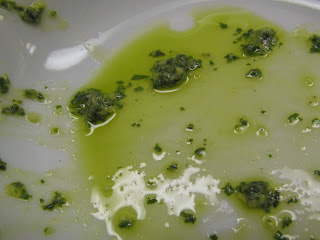At the end of the summer, August or September, pesto is a good use of all that overgrown basil you might have.
It wouldn't grow at the beginning of the season, and now you're drowning in it...
You can freeze it for a little later in the year for some summery flavor, too. Just make sure that air doesn't get to it. Oxidized basil ain't so pretty, folks.
However, blanching the basil will help keep it a brilliant green.
Freshly made pesto is so much better than jarred.
Use it on pasta, gnocchi, risotto, polenta, in dips, on a tomato salad, for bruschetta, on chicken or fish... thin it with a little more oil and it can be a fantastic bread dip.
The technique of turning garlic cloves into garlic paste helps give the strongest garlic flavor possible. If all the cells in a clove of garlic are broken down, then the compounds which give garlic it's garlickyness are released. Plus, it's smooth and more easily incorporated into the rest of the sauce.
Little bits of pine nuts, yes.
Little chunks of raw garlic? Whew. I'm not sure I'm a fan of those.
And so, to make garlic paste, start with minced garlic on a cutting board. Sprinkle the bits of garlic with kosher salt, and smash the garlic by adding a little pressure and dragging the flat side of the knife over it, the blade facing away from you. Scrape, pile it up, scrape in a different direction... and continue until it's a relatively smooth consistency.
Depending on what you want to do with it, you can leave the sauce thick and spreadable, or make it more loose with a little extra olive oil.
Pesto Genovese
makes about 2 c
4 c fresh basil, packed (about 6 oz by weight)
3 cloves garlic, minced
Kosher salt
2/3 c pine nuts, lightly toasted in a dry pan (only a few minutes, warmed through and very lightly colored)
2/3-1 c olive oil
2/3 c finely shredded Parmesan cheese
1/4 c finely shredded Pecorino Romano cheese
Freshly ground black pepper
Bring a large pot of water to boil. Once the water boils, prepare an ice water bath in a large bowl and set aside. Add the basil leaves to the boiling water and quickly remove them to the bowl of ice water after 30 seconds. Cool and drain well.
Have the minced garlic ready on a cutting board and sprinkle with 1/2 t kosher salt. Find a large chef's knife with a wide blade and place the flat side of the knife on top of the garlic, blade facing away from you. Apply some pressure and drag the knife across the garlic. Scrape it all together, and drag the knife across again. Continue until the garlic is a relatively smooth paste.
In the bowl of a food processor combine the blanched basil, garlic, pine nuts, and 2/3 c olive oil. Process until well-combined and the basil and pine nuts are broken down. Add the Parmesan and Pecorino Romano cheeses as well as 1/2 t black pepper, and pulse until incorporated.
Add extra olive oil to thin to desired consistency. Season to taste with extra salt and pepper.
To store: Place in jars or other containers in the refrigerator covered with a thin, extra layer of olive oil before closing. It should last in the refrigerator at least a week.
To freeze: Place desired amounts of pesto in small freezer bags, containers, or jars (maybe about 1/2 c per lb. of pasta or gnocchi?). Make sure all of the air has been removed before sealing the bags or add a thin layer of olive oil to top off the containers. Defrost in the refrigerator or at room temperature. Pesto should last several months frozen.



















Is that gnocchi in the first picture?
ReplyDeleteLooks so good!
Ahhh, Fridays...
Yes, it is.
ReplyDeleteAh, gnocchi...
What is gnocchi?
ReplyDelete(Can't leave my name for this question.)
Gnocchi are little dumplings- these are potato and flour- probably with egg to help bind them.
ReplyDeleteI have a recipe for pumpkin gnocchi here somewhere if you do a search... in case you're wondering how they're made.